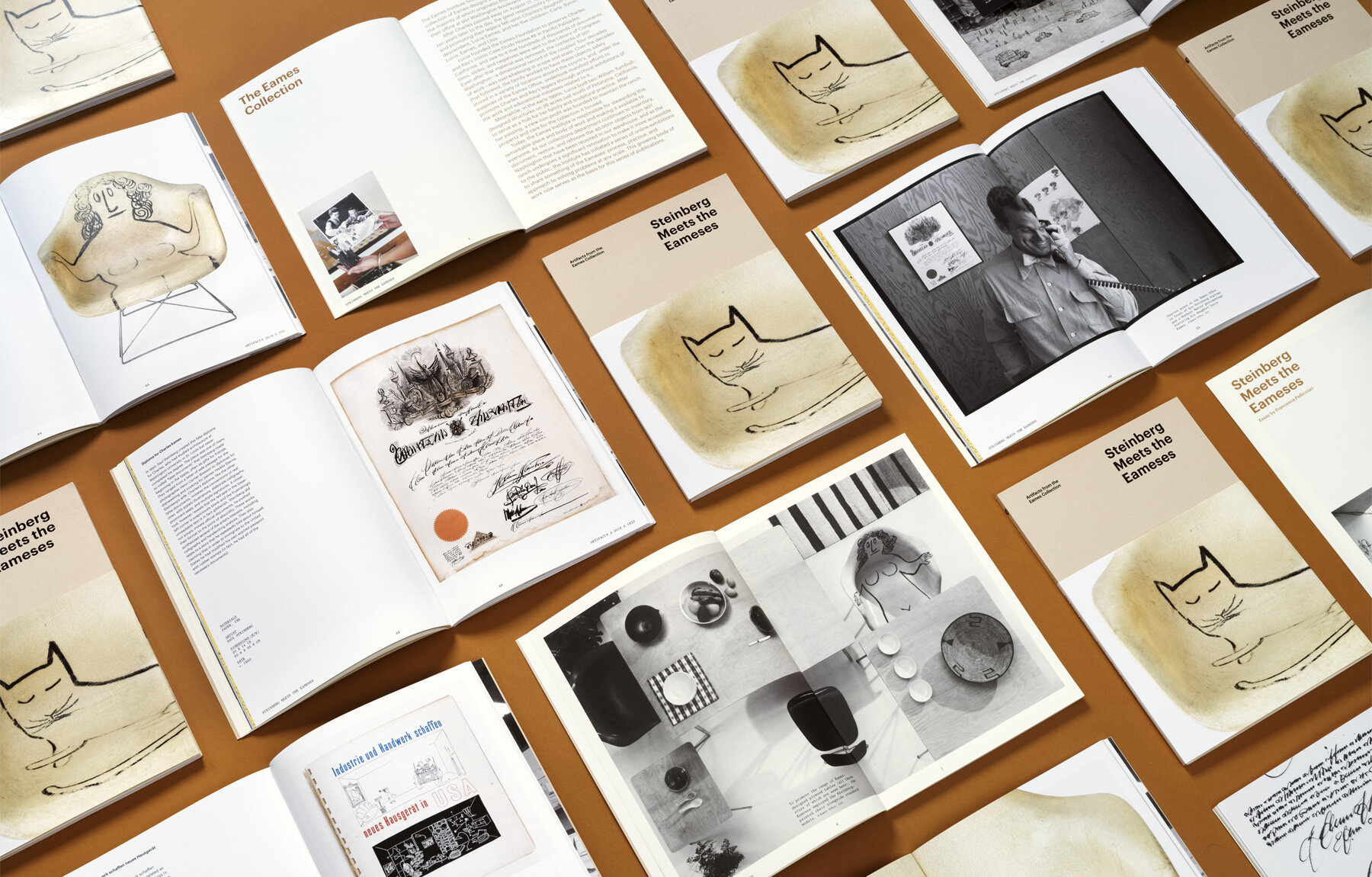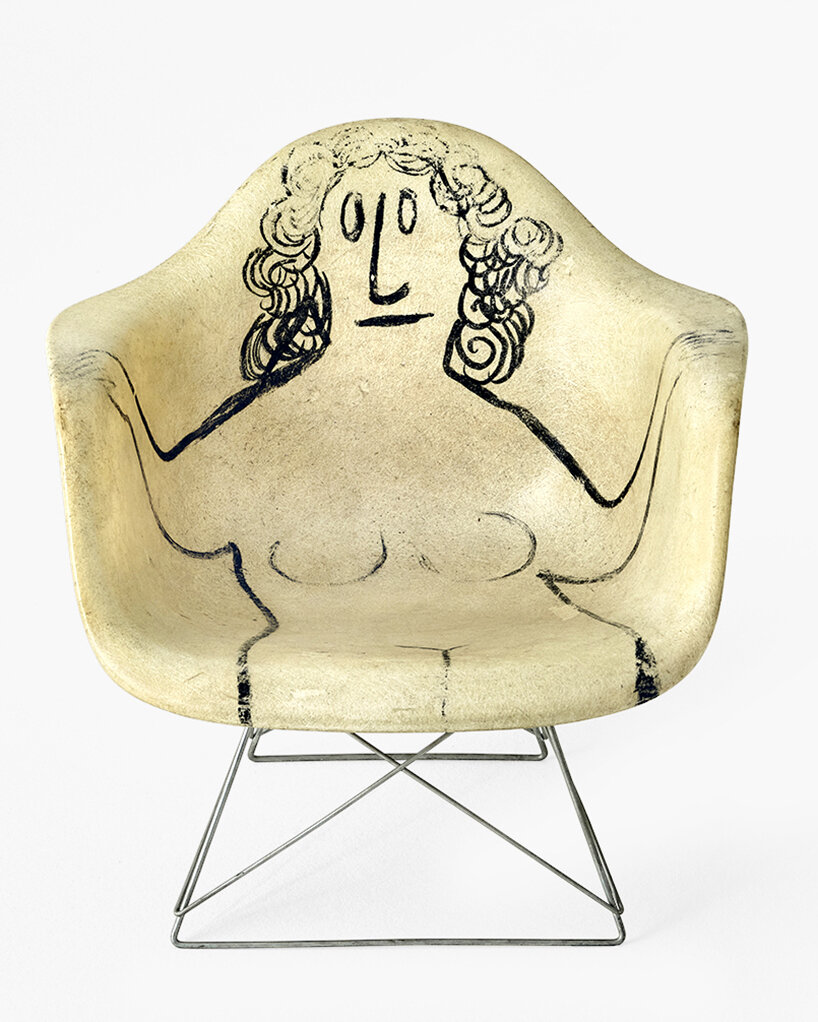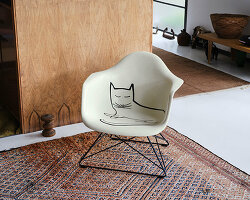how charles & ray eames met saul steinberg
On June 14, 2023, the Eames Institute of Infinite Curiosity launched Steinberg Meets the Eameses, its eighth online exhibit that celebrates the relationship between design icons Charles and Ray Eames and Romanian-American artist Saul Steinberg — showcasing the collaborative works that resulted from an extraordinary encounter between both parties in the summer of 1950. The exhibition coincides with the newly recreated Eames Fiberglass Armchair launch with Steinberg Cat by VITRA and Herman Miller. The Eames Institute retains two original Steinberg-painted chairs—including the chair with cat—in the Eames Collection.

Steinberg Cat among other fiberglass chairs | image © Peter Stackpole – The LIFE Picture Collection
all images courtesy Eames Institute
Steinberg Meets the Eameses begins with the story of a botched Hollywood assignment that led Steinberg to the West Coast and how he then came in contact with the Eameses (see more here). It details the now iconic works that resulted from a collaborative day spent at the Eames Office at 901 Washington Boulevard in Venice, California—including the chair with a cat and another chair painted with a nude figure (both of which remain in the Institute’s holdings). Several works stemming from their iconic bond also take center stage, namely the officious but entirely illegible diploma Steinberg bestowed on Charles Eames (because the designer never finished school), and photographs taken by Eames of Steinberg drawings projected onto the artist’s wife, Hedda Sterne, and Ray Eames.
‘The interconnection of Steinberg’s ideas and how this overlapped into the designs of my grandparents is incredible,’ writes Llisa Demetrios, the Eameses’ youngest granddaughter, and the Institute’s Chief Curator. ‘I think this collaboration is exemplative of how they liked to create— always open to another creative iteration, going beyond what’s expected.’

Steinberg arm shells displayed within the designers’ workspace | image © Eames Office, LLC.
the exhibition spotlights the steinberg-painted armchairs
Launched in 1950, the Eames Shell Chairs were the world’s first industrially mass-produced chairs with seats and backrests formed from a one-piece plastic shell. The design is characterized by this novel combination of seat and back into a unified shell, and it was precisely this innovation that provided Steinberg with a continuous surface on which to draw. As contemporary works by the artist attest, he explored the possibilities of drawing onto three-dimensional surfaces and environments and then photographing the results. The chairs created at the Eames Office result from just such a scenario in which Steinberg painted onto multiple objects and surfaces.

Fiberglass Armchairs with Steinberg Cat and Steinberg Nude (1950)
For the Steinberg Cat, the story goes back to 1950 when the artist spent two months living in Hollywood and socializing with the Eameses and other luminaries like Igor Stravinsky and Gene Kelly. During one notable visit to the Eames Office at 901 Washington in Venice, California, Steinberg transformed several pieces of Eames furniture by drawing directly on their surfaces. Steinberg had begun drawing on objects and walls the previous year, striking out from the confines of the two-dimensional page in a way that allowed him to experiment with materials, scale, and space—all familiar concerns thanks to his architectural training at the Politecnico in Milan. In this case, Steinberg nestled the image of a sleeping cat into the molded curve of an Eames fiberglass armchair. This chair is notable because it was the Eameses’ first commercial molded plastic design and had only recently been introduced by the Herman Miller Furniture Company.
The chair is characterized by its novel combination of seat and back into a unified shell, and it was precisely this innovation that provided the artist with a continuous surface on which to draw. The cat was a common motif in Steinberg’s work, one of many animals he often represented. For Steinberg, animals were at once ordinary and extraordinary. He once commented, ‘Dogs and cats are man-made,’ referring not only to their long history of domestication but also to the prominent role that animals play in the discursive world of symbolism and allegory.

Saul Steinberg, Eames Chair (1951) | ink and watercolor on paper, 29.2 x 36.8 cm | Artis— Naples, The Baker Museum | Gift of Olga Hirshhorn, 2013.1.186 | image © The Saul Steinberg Foundation / Artists Rights Society (ARS), New York
That very same year, the Steinberg Nude also came to life. During one notable visit to the Eames Office at 901 Washington in Venice, California, in June of 1950, Saul Steinberg transformed several pieces of Eames furniture by drawing directly on their surfaces. Steinberg had begun drawing on objects and walls the previous year, for instance drawing on a bathtub in such a way that made it appear that a woman was relaxing inside. And in another similar example, he perched a female figure on the edge of a tub.
This chair was one of two that Steinberg decorated with a female nude when he visited the Eameses. As initially staged and photographed in the office, the fiberglass armchair was displayed without a base. This enabled its drawing to extend off the edge of the shell and onto the floor below, completing the figure’s legs. The chair caused an uproar when it was exhibited the following year—now on a simple metal base—in Long Beach, California. Perceived as playful by some and vulgar by others, newspapers reported that the chair was turned around to hide its occupant at one point, only to be turned back around later to return her to view.

Charles Eames + Steinberg Nude on La Chaise mold | image © Peter Stackpole – The LIFE Picture Collection
gifts to friends: how charles eames’ fake diploma came to be
Going back to the diploma — in 1950, Saul Steinberg created this fake certificate for Charles, who had studied architecture at Washington University in St. Louis but never completed his degree. The piece was one of many so-called ‘false documents’ that the artist made beginning in the 1940s, often as gifts for friends. They ranged from a letter of safe passage for the photographer Henri Cartier-Bresson to diplomas for dishwashing and cooking for painter Hedda Sterne, Steinberg’s wife. Like the other false documents, Charles’s diploma imitates the conventions of real ones, with stately illustrations, elaborate calligraphy, prominent seals, and multiple signatures.
A closer look, however, reveals that the red seal in the lower-left corner is suspiciously blank and the frustratingly unreadable text is, in fact, gibberish. Steinberg did not simply imitate official documents; he pushed their format to absurdity. These works synthesized several of the artist’s interests, including calligraphy and handwriting analysis. They also relate to a story he repeatedly told about himself, claiming that to immigrate to the United States, he had modified his expired passport with rubber stamps (in fact, he had all the necessary documents).

Saul Steinberg’s Diploma for Charles Eames (c. 1950) | ink on paper, 50.8 x 35.6 cm
a physical tribute to steinberg meets the eameses
To accompany the opening of Steinberg Meets the Eameses, The Eames Institute will be releasing a limited edition book delving into the manifold connections between Steinberg and designers Charles and Ray Eames—and details the flurry of creativity that emerged from the storied encounter in the summer of 1950. The two original painted chairs, alongside other Steinberg- and Eames-related artifacts and ephemera, are comprehensively documented and complemented by archival photographs, artwork, and an essay from noted Steinberg scholar and curator Francesca Pelliciarri.
Pellicciari, co-curator of the career-spanning 2021 exhibit ‘Saul Steinberg: Milan, New York’ at the Triennale di Milano, contributes an informative essay that delves into the manifold connections between the Eameses and Steinberg and the respective places they hold in each others’ worlds. ‘Steinberg was ever-observant of America’s changing cultural landscape,‘ she writes, ‘and seemed to delight in the widening gulf between popular tastes and the vanguard of modernist art and design.’

Saul Steinberg, Woman in Tub (1949) | Gelatin silver print, 12 ¾ x 11 ¼ in. | Private collection | image © The Saul Steinberg Foundation / Artists Rights Society (ARS), New York

photograph of Steinberg drawing projected onto Hedda Sterne (c. 1950)

photograph of Steinberg drawing projected onto Hedda Sterne drinking (c. 1950)

compilation of the catalog







exhibition info:
name: Steinberg Meets the Eameses
location: The Eames Institute of Infinite Curiosity | @eamesinstitute
opening date: June 14, 2023
chair design (634)
charles and ray eames (20)
exhibition design (589)
PRODUCT LIBRARY
a diverse digital database that acts as a valuable guide in gaining insight and information about a product directly from the manufacturer, and serves as a rich reference point in developing a project or scheme.



















